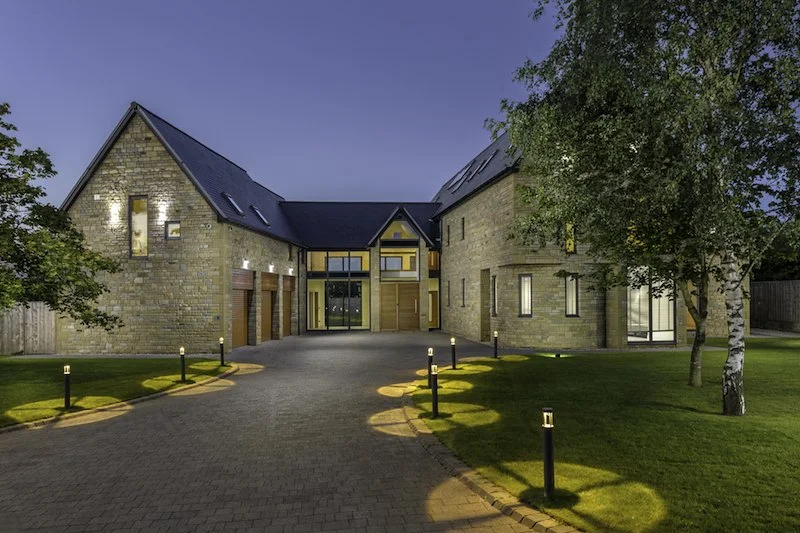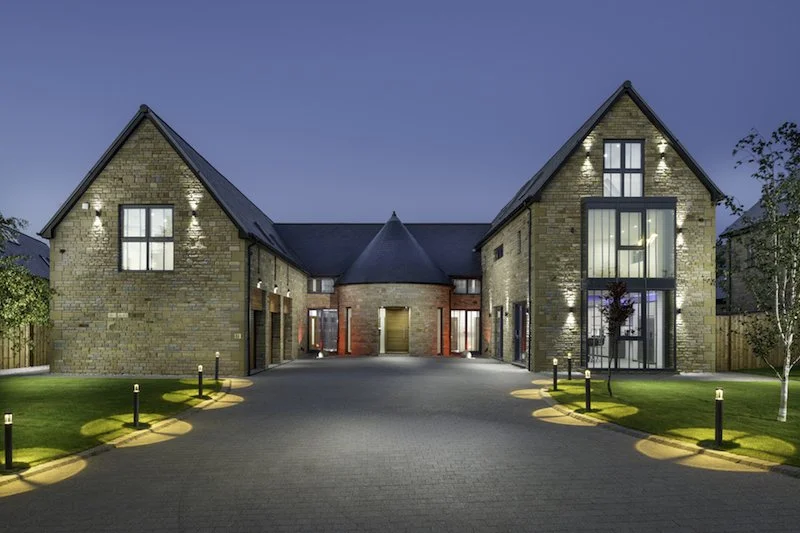Big night out
Following on from the day that I shot two multi-million places at Ramside Hall in Durham, I was asked to head back to shoot the classic twilight shots. I’ve done loads of these, and I tend to favour a specific, quite complicated technique of using lots of additional lighting to accentuate the fascia and detailed surrounding environment rather than the simple method of sticking the interior lights on, waiting until it goes dark, and taking a shot. Each twilight image is the composite of around 50-60 frames, covering all aspects and exposures to create something fairly spectacular at the end. This particular night was perfect. The sky was cloudless, and the road was clear. Only one complication though – you get about 30 minutes to shoot the various frames during the time after sunset, but I had to shoot both properties at the same time. There was only one solution – a tandem setup.
The properties were about 200m apart, and so I had to set up two heavyweight tripods with cameras & lenses on each. My Camranger remote control unit would have to be shared between locations using the power of my legs. I’d just gone under the knife for a hernia-repair operation a couple of weeks earlier, and I was conscious of damaging myself by exerting myself too early, so had to watch what I was doing. The technique to shoot these is as follows:
Set up the composition for the shot and lock the tripod head down – nothing can move thereafter.
Prepare all equipment ready to shoot, and switch all the internal lights on.
Set the camera to 1/2 sec at f11 and wait for 30 minutes after sunset.
Capture a range of exposures over and under the initial 1/2 sec to capture the deep blue sky, the fascia of the building, any exterior lighting, and the internal lights.
Once you have the range of initial exposures, set the camera to about 1/8th sec at f11 and use a flash on an extended monopod to highlight specific parts of the building exterior and gardens/walls etc.
Cover everything so that you have every part of the scene covered in separate frames.
The rest of the photo is created in post-production by compositing various exposures and flash highlights to your hearts delight. It can be as colourful or low-key as you like, and all depends on personal preference. This is my style, and that’s that. You only get about 10 minutes to get the initial frames because the light drops off extremely quickly. Consequently, I was sprinting back and forward with the Camranger to get those shots off. After that, the time doesn’t matter as the output from the flash is always consistent, and you could do it in the pitch black. I had a bit of a scare at one point, as a Mini full of girls trying to spot a footballer’s house (a common occurrence here) came flying round the bend and headed down the road where my tripod and £6K worth of gear was standing. It’s a no-through road, and there was no reason to suspect anyone would go down there. I just had to stand and watch as the car hurtled towards the gear. I’d taken the step of attaching a flappy bit of HV stuff to the tripod just in case, and perhaps this worked as the car suddenly swerved around the kit, did a U-turn at the bottom of the road, and hurtled back up. the damage to gear and car would have been horrific.
Nobody else in the North East does these with as much care or attention to detail. I’ve got another few scheduled shortly, and it’s just a case of waiting for conditions to be suitable. Trying these when it’s overcast just results in an orange mush of a sky, and looks awful. I’ve seen people try replacement skies, but that’s for amateurs and last resorts.
Do it right.

